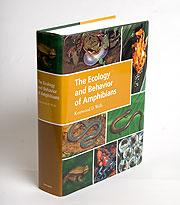  |
| HOME | THIS ISSUE | CALENDAR | GRANTS | BACK ISSUES | < BACK | NEXT > |
Biologist’s book on amphibians seen as major contribution to fieldby Cindy Weiss - November 26, 2007 |
||||
| Kentwood Wells keeps a collecting net close at hand, near the door to his office. It is the indispensable tool of his lifelong quest to capture knowledge about amphibians. When he was 12 years old, he began chasing after frogs near his northern Virginia home. As a teenager, he published his first article about toads in the Virginia Herpetological Society newsletter. Now a professor and the department head of ecology and evolutionary biology, he admits that he “never outgrew it.” In fact, he just published what others are calling the definitive book on amphibians. After 20 years in various states – from field notes to chapters to proofs – The Ecology and Behavior of Amphibians (University of Chicago Press) has metamorphosed into a five-pound book with 1,150 pages, including 250 pages of references and a 64-page index he prepared himself. “There has never been another book like it,” says Kurt Schwenk, professor of ecology and evolutionary biology and a fellow herpetologist, although he mostly studies reptiles rather than amphibians. “It will be the standard reference work on amphibians for several generations of vertebrate biologists,” Schwenk says, “and the Rosetta stone for anyone even remotely interested in the group.” When Wells started the project, he wrote chapters on a portable electric typewriter, and the biological illustrator at UConn at that time, Mary Jane Spring, used a Leroy mechanical lettering set in producing the figures.
The second biological illustrator, Virge Kask (Spring retired before the book was finished), converted the early figures to a digital format and prepared many new ones for later chapters. These weren’t the only changes during the long-running project, however. Over the years, “the amount of research about amphibians has gone up exponentially,” says Wells. Several amphibian species have become extinct since he started working on the book. Along the way, he has contributed to journals and specialized books about amphibian biology in his areas of expertise – social and territorial behavior and communications, parental care, vocalization, and mating systems. He covers all that and more in his new comprehensive work. The last chapter is on conservation, an area that has drawn increasing attention from the media in recent years because of concerns about declines in amphibian populations around the world.
There are four or five major causes for declining populations, including habitat destruction, disease, and introduced exotic predators, Wells says. Declines in areas where there is otherwise pristine habitat, such as Yosemite National Park and protected areas of Central America, are of real concern, he adds. Some of that is due to a fungal disease, the origin of which is not yet clear. There also have been frequent news stories about frogs with deformed limbs. The deformities often have gotten confounded in the popular press with the decline, says Wells. Some frog deformities are due to a parasite that attacks tadpoles, he says, adding that the problem tends to be localized and is not a widespread cause of amphibian declines. One of the most interesting amphibian behaviors he has studied is now being investigated in more detail by one of his doctoral students, Kristina Hurme, in Panama, the site of Wells’ early field work. It involves a mother frog who communicates to her dense tadpole school by bobbing up and down and creating waves to communicate the need to move, perhaps to get more food or to avoid predators. This is very sophisticated parental behavior for a frog whose brain is the size of a pencil eraser, he says. Wells began his work in Panama after he earned his Ph.D. at Cornell, with a postdoctoral fellowship with the Smithsonian Tropical Research Institute. For several years his research in Panama was funded by the National Science Foundation and the National Geographic Society. Locally, Wells finds dense aggregations of American toads to study around the Fenton River, and bullfrogs and green frogs at a farm pond in Lebanon, where he has worked with another of his graduate students, Susan Herrick. Wells, who came to UConn in 1977 and began writing the book in the 1980s, admits that writing such a comprehensive volume “sort of takes over your whole life.” Working on it cut down on the number of journal articles he could write, he says, but it is likely to be a more long-lasting contribution to the field. Reviewer Marty Crump, adjunct professor of biological sciences at Northern Arizona University and a leading amphibian researcher, comments, “the book is truly a masterpiece. Every topic that Wells addresses is a stunning synthesis of the state of our knowledge.” |
| ADVANCE HOME UCONN HOME |

 Wells graduated to an IBM Selectric, then to a green-screen mainframe terminal, and wore out three PCs before he was done.
Wells graduated to an IBM Selectric, then to a green-screen mainframe terminal, and wore out three PCs before he was done.